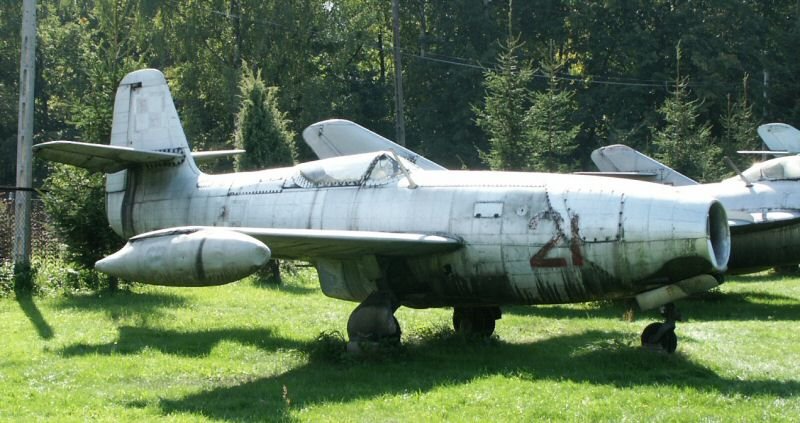- Yakovlev Yak-23
infobox Aircraft
name =Yak-23
type =Fighter aircraft
manufacturer =Yakovlev 
caption =Yak-23 in Muzeum Orła Białego in Poland
designer =
first flight =8 July 1947
introduced = 1949
retired = 1951 (Soviet Union) 1961 (Poland)
status =
primary user =Soviet Air Force
more users =Polish Air Force Romanian Air Force Hungarian Air Force
produced = October 1949-1950
number built = 310
unit cost =
developed from =Yakovlev Yak-17 Yakovlev Yak-19
variants with their own articles =The
Yakovlev Yak-23 (in Russian Як-23, NATO designation "Flora") was a jet fighter developed in the USSR in the 1940s, used in early 1950s.Design and development
The Yak-23 was developed as a simple lightweight jet fighter, on Yakovlev's own initiative. It was a development of the earlier Yak-15 and Yak-17 fighters, retaining their non-conventional layout with a
jet engine in thefuselage nose and exhaust under thecockpit , but the construction was all new. Its wings were derived from the Yak-19. The Yak-23 used a Soviet copy of the BritishRolls-Royce Derwent Vturbojet engine, produced as theKlimov RD-500 . It first flew onJuly 8 , 1947. After successful flights, it underwent state trials in 1948 and was accepted for series production. It was evaluated as highly maneuverable, with a good acceleration and take-off and climb capabilities thanks to high thrust-to-weight ratio. Faults were poor directional stability at speeds around Mach 0.86 and lack of cockpit pressurization. Despite being one of the best straight-wing jet fighters, it was inferior to new swept-wing designs.Operational history
The first aircraft were produced in a factory in
Tbilisi in October 1949. In late 1949 they enteredSoviet air force service, and were also ordered for export in 1949-50. The Yak-23 was quickly replaced in the Soviet service with the more complicated swept-wingMiG-15 , which offered superior performance. In all, only 310 Yak-23 aircraft were built before production ended in 1950. Apart from the fighter, the Yak-23UTI two-seat trainer was developed, with an instructor's cockpit extended towards the aircraft nose. Sources differ, whether it was produced at all or in a small batch.Small numbers of Yak-23 were exported to
Czechoslovakia (20 from 1949, named S-101),Bulgaria (from 1949),Poland (about 100, from 1950),Romania (62, from 1951),Hungary and probablyAlbania . Poland and Czechoslovakia acquired licence of Yak-23, but didn't start production in favour of the MiG-15. Yak-23s were withdrawn by the late 1950s. They were not used in combat (there are reports of US pilots encountering Yak-23s during theKorean War , but their presence inNorth Korea is not confirmed). Fact|date=September 2008US testing
A single Yak-23 was acquired by US intelligence, probably via
Yugoslavia , in November, 1953. The aircraft arrived disassembled, and was shipped to the Air Force Test and Evaluation Center atWright Field nearDayton, Ohio . It was reassembled and made operational for several flight tests, during which time it was disguised with U.S. markings. Efforts were made to keep the aircraft's identity secret, and it was only flown in the early morning. On one occasion it was passed on therunway by a formation ofF-86 's, whose pilots inquired as to the plane's identity. A story was conceived that the aircraft was aBell X-5 , which had a similar layout. At the completion of design and flight evaluations the aircraft was again disassembled and shipped quietly back toYugoslavia in its original paint scheme.Records
On September 21,
1957 , the Polish pilotAndrzej Abłamowicz set two FAI world records on Yak-23 with civilian markings SP-GLK, in its weight class, climbing at 3000 m in 119 seconds (4962.6 fpm) and at 6000 m in 197 seconds (5995.4 fpm). This plane was withdrawn in1961 , being possibly the last Yak-23 used in the world.Variants
;Yak-23:Fighter version, serial built.;Yak-23UTI:Two-seat training version with longer fuselage and lighter armament, prototype only.;Yak-23DC:Romanian-built two-seat training version. Four Yak-23 single-seaters were converted in 1956 by ASAM Pipera, two of them belonging to the Bulgarian AF.;S-101:Czech designation.
Operators
;ALB
*Albanian Air Force ;BUL
*Bulgarian Air Force received at least 12 aircraft in 1949.;CZS
*Czechoslovak Air Force received 20 aircraft in 1949.;POL
*Polish Air Force received about 100 aircraft operated between 1950 and 1961;ROM
*Romanian Air Force received 62 aircraft in 1951, used them until 1958;USSR
*Soviet Air Force operated aircraft between 1949 and 1951.;flag|United States|1912
*United States Air Force operated one aircraft in November 1953 for flight tests.pecifications (Yak-23)
aircraft specifications
plane or copter?=plane
jet or prop?=jet
crew=one
length main=8.12 m
length alt=26 ft 8 in
span main=8.73 m
span alt=28 ft 8 in
height main=3.31 m
height alt=10 ft 10 in
area main=13.50 m²
area alt=145 ft²
empty weight main=1,980 kg
empty weight alt=4,356 lb
loaded weight main= 3,384 kg
loaded weight alt=7,445 lb
max takeoff weight main= kg
max takeoff weight alt= lb|engine (jet)=Klimov RD-500
type of jet=turbojet
number of jets=1
thrust main=15.6 kN
thrust alt=3,500 lbfmax speed main=923 km/h
max speed alt=577 mph
range main=1,400 km
range alt=875 miles
ceiling main=14,800 m
ceiling alt=48,500 ft
climb rate main= 41.4 m/s
climb rate alt= 8150 ft/min
loading main=251 kg/m²
loading alt=51 lb/ft²
thrust/weight=0.46armament=
* Guns: 2× 23 mmNudelman-Rikhter NR-23 with 90 rounds eachee also
aircontent
related=
*Yakovlev Yak-15
*Yakovlev Yak-17
*Yakovlev Yak-19 similar aircraft=
*Mikoyan-Gurevich MiG-9
*FMA Pulqui sequence=
* Yak-19 - Yak-20 - Yak-21 - Yak-23 - Yak-24 - Yak-25 - Yak-26lists=
*List of fighter aircraft
*List of military aircraft of the Soviet Union and CIS see also=
References
External links
* [http://forum.valka.cz/galerie/thumbnails.php?album=328 Gallery of Jak-23 in Praha-Kbely museum]
Wikimedia Foundation. 2010.
